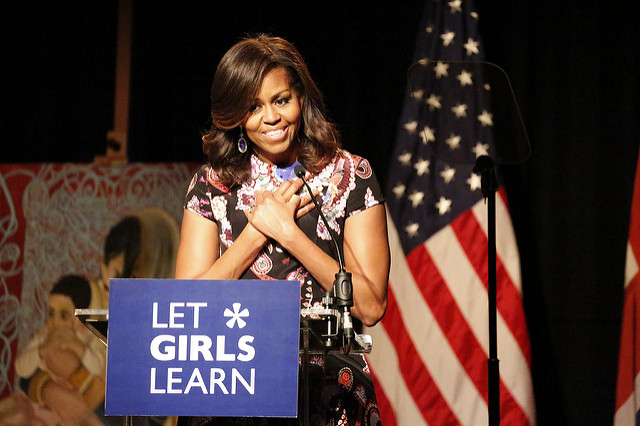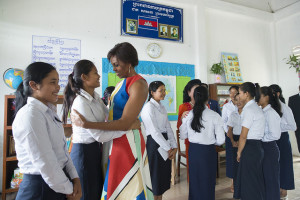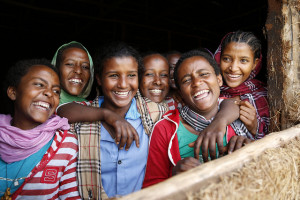Michelle Obama’s Legacy: A Global Advocate for Girls’ Education
 U.S. First Lady Michelle Obama speaking in London about Let Girls Learn and new global development projects aimed at increasing girls' access to education. https://flic.kr/p/uJMJYV
U.S. First Lady Michelle Obama speaking in London about Let Girls Learn and new global development projects aimed at increasing girls' access to education. https://flic.kr/p/uJMJYV
As the Obamas get ready to leave the White House on January 20th, their legacy has become a topic of interest nationally and internationally. Michelle Obama, the United States’ first black First Lady, has spearheaded and organized numerous successful initiatives in the past eight years. She has not approached the role of First Lady in a similar fashion to her predecessors; instead, she looked inward to her own experiences and aligned them with her work to put the country on a better path. Her first large scale campaign, Let’s Move, focused on reducing child obesity by promoting active lifestyles and healthy eating at school and at home. She has also worked closely with Jill Biden, Vice-President Joe Biden’s wife, on Joining Forces, a program that brings together corporations, non-profits, and the government in order to expand access to healthcare and employment. While the First Lady’s initiatives domestically should not be understated, it is her most recent program that has, and will continue to have, the largest global impact.
In March 2015, First Lady Obama launched Let Girls Learn, a multi-department initiative which is funded primarily through the U.S. Agency for International Development (US AID). The ultimate goal of the program is to give teenage girls in the developing world the opportunity to attend safe, quality schools in their home countries. Michelle Obama’s leadership on this issue in the past year has ensured that the United States government, non-governmental organizations, foreign countries, and private companies have increased funding for initiatives that tackle the pervasive and multidimensional root causes that hinder young girls from attending school. US AID reported in 2016 that 62 million girls worldwide still do not have access to formal primary or secondary education. While the number of girls attending school, especially in the developing world, has increased in large part by the Millennium Development Goals, there continues to be numerous economic, social and cultural barriers for girls. Let Girls Learn, although less than two years old, does not focus on merely building schools and providing scholarships, but on rupturing the inferior social standing of young girls and addressing the root causes of academic disadvantage.

Michelle Obama’s work through Let Girls Learn has the opportunity to become a successful global movement for two important reasons. Firstly, it combines funding and policy ideas from governments, NGOs, and community programs, ensuring an important balance of voices within the movement. Secondly, it attempts to defeat systemic social and cultural barriers that reduce access to education while continuing to develop much needed infrastructure and programs that will allow girls to safely attend quality schools. In the short two years since the First Lady spearheaded this initiative, multiple global players have signed on in support of the cause. US AID, the primary American governmental agency funding Let Girls Learn, has invested upwards of $600 million,and plans to add at least an additional $100 million in 50 countries for the upcoming year. Michelle Obama has also been leading the charge to get other governments to increase international development investments into girls’ education programs. She has collaborated with countries like Canada, Mexico, the United Kingdom, South Korea, and Japan, which has resulted in an investment promise of nearly $600 million from these countries towards girls’ education efforts. In addition to government investments, Obama has been a global leader in working with the private sector. In the past year, more than $5 million has been pledged by private companies to Let Girls Learn, including from Newman’s Own, CNN, and Alex and Ani. The First Lady has even been at the centre of the largest investment promise for adolescent girls’ education by any non-governmental organization, as she joined the World Bank in April 2016 to announce a $2.5 billion commitment to the movement.
While the increased funding for girls’ education is clearly integral, Michelle Obama has made sure that the increased investment does not solely go to national governments but to community level organizations as well. For instance, in Liberia, one of the 13 countries receiving US AID money through Let Girls Learn, investments have been made to the government, to numerous public-private partnerships, to community based initiatives, and to Peace Corps ground work. In Morocco, the government, along with individual schools and communities, will be receiving aid through Let Girls Learn to make schools more accessible to girls (through hygiene products, transportation, and security) and to build dormitories so that rural girls can attend secondary schools. These are just a few examples of the multi-stakeholder approach, regarding investment, policy, and initiatives that Michelle Obama is helping to lead in the developing world.

Obama’s vision of her program, and all others concerning girls’ education, examines lack of access to education for girls not merely as an educational or infrastructural problem, but as a grander societal and cultural problem. By looking at both the macro and micro issues surrounding girls’ education, and trying to focus on both of them simultaneously, Obama is well on her way of being the leader of meaningful and successful changes for girls worldwide. She understands that building a school may be helpful, but it will do nothing without changing some minds concerning a girl’s’ right to education. Yet she also understands the alternative side: if improvements are not made to the actual educational system and schools, there will be no incentives for society to change and to see the massive benefits that come with increased education for girls.
Michelle Obama understands that the two main obstacles— improvements in infrastructure and policy and addressing cultural beliefs that perpetuate this educational crisis— are not mutually exclusive. In order to truly create educational opportunities for young girls in the developing world, programs and funding through Let Girls Learn do not look to achieve quick and outright solutions. Instead, improvements concerning girls education will occur in steps. While Let Girls Learn, and other initiatives in which Obama is playing an increasingly larger role, do invest in school construction, decrease school fees and building adequate bathrooms, they also work hard in order to prosecute rapists, change male dominated workforce philosophies, and transform negative perceptions of girls’ education in parts of the developing world. Scholarships, bathrooms, transportation, and school supplies will only go so far if communities do not believe there to be any benefit of girls receiving education or if they choose not to punish rapists of school age children. Michelle Obama understands this complex problem, and is leading the movement to change both the root of the problem and lacking educational infrastructure in the global south.

While her work for Let Girls Learn occurs outside of the United States, Michelle Obama’s personal experiences appear to be at the centre of her involvement in the girls’ education movement. She struggled, as an intelligent young black woman, to find the means to attend school, gain the respect of her peers and a find a sense of self-worth while in high school and university. In addition, her work raising two young girls while living in the White House (only the second First Lady to do so since President Jimmy Carter) has had an impact on how she understands the barriers that girls face in accessing education. She has often explained the importance of education in her life and the lives of her daughters, and how their educational achievements have put into perspective the lack of opportunities that many other girls do not have. Obama has not shied away from connecting her personal experiences to the movement, stating that “for me, education has never been simply a policy issue – it’s personal.” It is through these personal experiences that First Lady Obama has created an initiative that examines a wide range of oppressions that impact girls worldwide.
Although her time as First Lady will soon end, Michelle Obama has made it clear that she will continue to travel the world, work with Let Girls Learn, other organizations and governments to advance this cause. In less than two years, her initiative has taken off; not only has she secured funding for extensive projects, she is mobilizing an entire global movement. While pundits will examine her legacy as First Lady, her role as a global leader for girls’ education is just beginning. As more global players begin to work alongside Michelle Obama and attempt to solve the social, cultural and economic problems that surround access to girls’ education, meaningful changes can be made for girls in the developing world.
